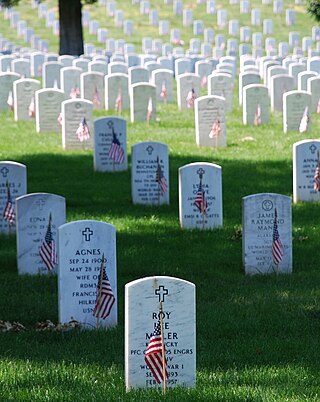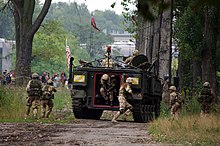
The Pythian Games were one of the four Panhellenic Games of Ancient Greece. They were held in honour of Apollo at his sanctuary in Delphi every four years, two years after the Olympic Games, and between each Nemean and Isthmian Games. The Pythian Games were founded sometime in the 6th century BC. In legend they were started by Apollo after he killed Python and set up the Oracle at Delphi. They continued until the 4th century AD.

Historical reenactments is an educational or entertainment activity in which mainly amateur hobbyists and history enthusiasts dress in historical uniforms and follow a plan to recreate aspects of a historical event or period. This may be as narrow as a specific moment from a battle, such as a reenactment of Pickett's Charge presented during the 1913 Gettysburg reunion, or as broad as an entire period, such as Regency reenactment.

Living history is an activity that incorporates historical tools, activities and dress into an interactive presentation that seeks to give observers and participants a sense of stepping back in time. Although it does not necessarily seek to reenact a specific event in history, living history is similar to, and sometimes incorporates, historical reenactment. Living history is an educational medium used by living history museums, historic sites, heritage interpreters, schools and historical reenactment groups to educate the public or their own members in particular areas of history, such as clothing styles, pastimes and handicrafts, or to simply convey a sense of the everyday life of a certain period in history.

A Renaissance Festival is an outdoor gathering that aims to entertain its guests by recreating a historical setting, most often the English Renaissance.

American Civil War reenactment is an effort to recreate the appearance of a particular battle or other event associated with the American Civil War by hobbyists known as Civil War reenactors, or living historians.

Buckskinning is a branch of historical reenactment concentrating on the fur trade with different areas in the period of the Old West. Participants may choose to portray mountain men, American Indians, traders, missionaries, or anybody else who might have been in the Rocky Mountains between 1800 and 1840.

Medieval reenactment is a form of historical reenactment that focuses on re-enacting European history in the period from the fall of Rome to about the end of the 15th century. The second half of this period is often called the Middle Ages. This multiplicity of terms is compounded by the variety of other terms used for the period.

The Battle of Waterloo reenactment is an annual modern recreation of the 19th century Battle of Waterloo on the original battlefield in Waterloo, Belgium.
In historical reenactment, authenticity is a measure of how close an item, prop, action, weapon, tactic, or custom is to what would actually have been used or done in the time period being depicted. For example, in most northern European medieval reenactment cotton is an inauthentic material—as opposed to wool or linen—though it would be authentic in more modern periods and events, such as American Civil War reenactment or World War II reenactment. Likewise, pop culture references and talking about modern events or objects is inauthentic.
Dark Ages reenactment is generally considered a sub-branch of Medieval reenactment focussing on the 1st millennium AD beginning with the fall of the Western Roman Empire and ending with the High Middle Ages.

Polytheistic reconstructionism is an approach to modern paganism first emerging in the late 1960s to early 1970s, which gathered momentum starting in the 1990s. Reconstructionism attempts to re-establish genuine polytheistic religions in the modern world through a rediscovery of the rituals, practices and contextual worldviews of pre-Christian pagan religions. This method stands in contrast with other neopagan syncretic movements like Wicca, and ecstatic/esoteric movements like Germanic mysticism or Theosophy.

Vintage base ball is baseball presented as if being played by rules and customs from an earlier period in the sport's history. Games are typically played using rules and uniforms from the 19th century. Vintage base ball is not only a competitive game, but also a reenactment of baseball life similar to American Civil War reenactment. Players dress in uniforms appropriate to the time period, and many teams appear to be direct copies of teams that existed in the late 19th century. The styles and speech of the 19th century are also used while playing vintage base ball.
The modern era or the modern period is considered the current historical period of human history. It was originally applied to the history of Europe and Western history for events that came after the Middle Ages, often from around the year 1500. From the 1990s, it is more common among historians to refer to the period after the Middle Ages and up to the 19th century as the early modern period. The modern period is today more often used for events from the 19th century until today. The time from the end of World War II (1945) can also be described as being part of contemporary history. The common definition of the modern period today is often associated with events like the French Revolution, the Industrial Revolution, and the transition to nationalism towards the liberal international order.
Classical reenactment tends to focus on portrayals of the Greco-Roman world, and especially on modern recreations of Roman legions and ancient Greek hoplites.

Middelaldercentret is an experimental living history archaeological open-air museum in Denmark, which depicts the Middle Ages in the Denmark of the late 14th and early 15th centuries. It is located in Sundby Lolland, some 4 km northwest of the centre of Nykøbing Falster on the waterfront of Guldborgsund.

Similar to a World War II reenactment, Korean War reenactments can be divided into two categories, "living history" or a public-oriented display or as a "tactical event", a closed event where participants re-create a battle or event of the war.

Regency reenactment is historical reenactment of the British Regency period. Groups portray the period from 1811 to 1820 through costume, manners, food, and social gatherings that celebrate the spirit of the era.

Renaissance reenactment is historical reenactment of events of the Renaissance period and the European Age of Exploration. In its broadest use, it encompasses reenactment of periods from the early 15th century through the mid-18th century. Reenactments of earlier events are commonly termed medieval reenactment, while more recent events are modern reenactment. Events and periods within Renaissance reenactment vary by region and nation, but include the English Civil War in the United Kingdom, the Eighty Years' War in the Low Countries, L'Escalade in Switzerland, the Polish–Lithuanian Commonwealth in eastern Europe, and the early colonial period in the United States and Canada.

The commemoration of the American Civil War is based on the memories of the Civil War that Americans have shaped according to their political, social and cultural circumstances and needs, starting with the Gettysburg Address and the dedication of the Gettysburg cemetery in 1863. Confederates, both veterans and women, were especially active in forging the myth of the Lost Cause of the Confederacy.














